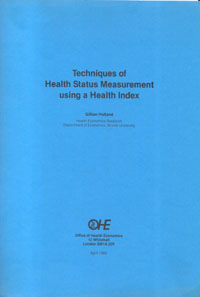Unlocking the Value of Combination Therapies

It is widely accepted that resources for the provision of health care are scarce, that is, there are not and never will be enough resources to satisfy either subjective “demands” for health care or externally measured “needs”. The use of resources in one…
It is widely accepted that resources for the provision of health care are scarce, that is, there are not and never will be enough resources to satisfy either subjective “demands” for health care or externally measured “needs”. The use of resources in one health care activity means the opportunity to use those same resources in a competing activity is automatically foregone (the economist ‘s notion of opportunity cost) (Drummond 1983). It is logical therefore that, for the purpose of resource allocation decisions, health care options should be compared in terms of their relative costs and benefits.
Fig 1 illustrates the components of costs and benefits encountered in a typical health care programme. Economic analysis and its techniques are simply a systematic way of measuring and displaying these in order to enable the decision maker to make a more informed choice.
Taking first the most simple form of economic appraisal, “Cost-analysis” involves the investigation of merely the direct or the direct and the indirect costs. Indeed, in that the benefits or consequences of health care interventions are ignored it may not be considered a form of appraisal at all. However, cost-analysis may be the appropriate method to use for comparing the costs of a new therapy with existing treatment options.
“Cost-benefit analysis” (CBA), which in the past has been applied to many health contexts ranging from mobile coronary care units (Acton 1973) to vaccination against infectious diseases (Adler et al 1983) entails the systematic comparison of as many costs and benefits as possible, with a view to determining which health care programme maximises the difference between the costs and benefits. In CBA both the costs and benefits are measured in commensurate terms, which usually, though not necessarily, means money terms. This gives rise to one major disadvantage of CBA, namely, that difficulty in measuring and evaluating intangible costs and benefits often results in these components being ignored and thus, to some extent, limits the usefulness of the analysis.
For this reason analysts frequently turn to “Cost-effectiveness analysis” (CEA), which serves to place priorities on alternative expenditures without requiring the monetary value of health outcomes to be assessed. In CEA resource costs are inevitably measured in money terms but the benefits may be expressed in physical units in a number of ways, such as life years gained and number of days free from disease. (Thus the practical difference between CEA and CBA is that the former requires commensuration of outcome measures within the major categories of resource cost and health effectiveness (benefits) whilst the latter requires that costs and benefits all be valued in the same units) (Weinstein 1981). CEA is a useful way of comparing alternative procedures whose effects are measured in the same units, and hence to assess the efficiency with which limited resources are being allocated to achieve the desired benefits. However, it suffers from the disadvantage that it cannot be used for comparing disparate alternatives, such as comparing kidney dialysis for renal patients with home care for the frail elderly.
“Cost-utility analysis”, (CUA) with which this paper is chiefly concerned, is a form of CEA in which the most generally used measure of effect is a “quality adjusted life year gained”. The extension to life, following medical intervention, is adjusted by a series of “utilities” which reflect the relative value of one health state to another. (This outcome measure has more recently become known as the QALY.) In that the QALY incorporates changes in survival and morbidity into a single measure reflecting trade-offs between them, it is a particularly useful outcome measure when the benefits of health activities can more appropriately be assessed in terms of their impact on the quality, not quantity, of life (Drummond 1984).Similarly, it is useful when the health activity being considered affects both mortality and morbidity and a common unit that combines both effects is desirable. This approach, CUA, is the appropriate technique for comparing programmes with a wide range of outcomes and for comparing one programme to others that have already been evaluated using CUA.
Economic analysis has been widely applied to the health field and there are numerous examples of each form of economic appraisal in the literature. Drummond (1981) has classified over 50 studies which illustrate these differences in approach.
Techniques of Health Status Measurement Using a Health Index
Holland, G.
(1985) Techniques of Health Status Measurement Using a Health Index. OHE Monograph. Available from https://www.ohe.org/publications/techniques-health-status-measurement-using-health-index/
